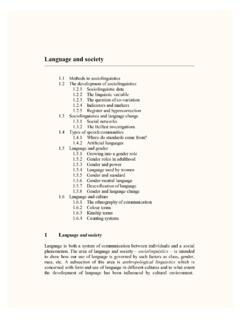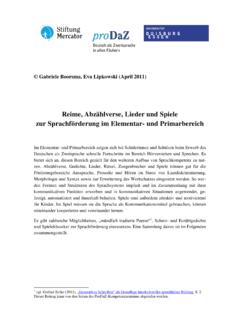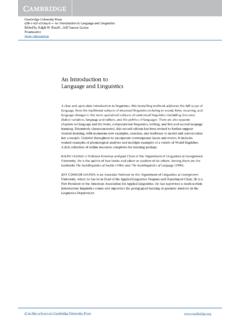Transcription of Language in Society and Language Use - Introduction
1 1 Language in Society and Language UseRaymond Hickey, SS 2018 Department of Anglophone Studies2 The following presentation is intended to give students an idea of what this course will be about. Basic principles and assumptions of sociolinguistics are explained in the following slides and typical concerns of the field can be begin with several reasons for going to this seminar are given and then possible themes for presentations and term papers are good reasons for going to the present seminar:1)To find out about how Language and Society interacts, how socialattitudes, social ambition and social bonding affect the manner in which people )To learn about how the internal structure of Language interacts with external social )To discover more about how languages change and how they don t, given the significance of social factors on this )To look as specific social situations and see how these general principles are confirmed or refuted.
2 Key sociolinguistic investigations, largely in America and Britain are of interest )To examine closely how speakers use social networks to stregthentheir identificaionwith the social group to which they feel they )To look at how men and women use Language to express the relationship of the sexes (gender-related Language use).7)To see how such socially relevant phenomena as politeness are expressed in different )To learn about the wider context in which societies are embeddedand how Language relates to culture in general (linguistic anthropology).
3 9)To throw new light on the relationship of the standard of a Language and the dialects which are also found. In the Anglophone context, to consider how and why regional standards arose and how countries,which are now independent, developed standards of their for presentations and term essays(these areas are quite large and issues within them can be treated separately in different sessions if students wish)1)The history of sociolinguistics 2)Models of sociolinguistics (accommodation, social networks)3)Individual sociolinguistic studies (New York, Norwich, Belfast, Dublin, etc.
4 (also possible: English overseas, extraterritorialvarieties)4)Sociolinguis tics and gender-related Language differences 5)Sociolinguistics and speech act theory 6 Areas for presentations and term essays (continued)6)Sociolinguistics, solidarity and politeness 7)Sociolinguistics and linguistic anthropology, ethnolinguistics8)Sociolinguistics and Language change9)Sociolinguistics and second Language acquisition 10)Sociolinguistics and education, Language planning 7 Sociolinguisticsas a separate discipline develops in the early sixties, first in the USA, later in Britain and then throughout the rest of the western world.
5 This is true although considerations of Language in relation to Society go back a considerable way and although the significance of Society for Language was stressed by the structuralistsat the beginning of the 20th century. Sociologyis the study of social structures. This is a discipline which was developed into its modern form in 19th century France and inGermany in the early 20th century. In its analysis of social forces it is of immediate relevance to sociolinguistics although sociology itself is not concerned with and sociology8 The basic assumption of sociolinguistics is that the variationwe can observe in Language is non-random, variation in Language is socially significant.
6 The task of the sociolinguist has been to quantify this variation and to give a principled account of its occurrence. In a nutshell the findings of sociolinguistics have shown that Language variation is largely determined by social class and status. Variation furthermore correlates with the relative security of a group sposition in Society with a general tendency of lower-status groups to imitate higher-status groups as long as this imitation has a chance of leading to an improvement of social status as with thelower-middle classes in the western world.
7 There is often a discrepancy between what speakers sayof their Language and what they practice. For instance in Peter Trudgill sstudy of English in Norwich it was shown that the working-class have a low opinion of their own variety of Language but continue to use it. This led to assumingthat varieties can have covertprestige for their basic assumptions9 Sociolinguistics and dialectology In a way it is true to say that sociolinguistics arose out of dialectology. Those linguists involved in this area in the last century and the beginning of the present century were interested in registering Language use and as such were half on the way to being sociolinguists.
8 However, many aspects of dialectological research are unacceptable to modern sociolinguists. The chief deficiency of the dialectological approach is that older, male, rural speakers were given preference as informants. This went against the basic principle of all sociolinguists, namely that the choice of informants be random and thus unbiased by the field worker. Characteristic of sociolinguistic methods are the following features: 1)The prior definition of one's area of investigation 2)The impartial choice of informants 3)The choice of optimal methods of investigation ( tape recordingrather than questionnaire)10 Gathering information The procedure of interviewing informants has the disadvantage that the field worker very often has a negative (or standardising) effect on the informants.
9 This is called the observer'sparadox, namely that the nature of the object of investigation changes under observation (more on this below). A dialogue situation in which the informant is not made aware of his status as informant is much more favourableand less likely to distort the of Language variation Just as the methods of the dialectologists were unacceptable to sociolinguists so was the terminology they used. For one thing the sociolinguists wanted to get away from the use of the term dialect. It carried with it the implication of a rural type of speech which is particularly conservative.
10 The more neutral term varietywas chosen which had the additional advantage that it did not imply implicit contrast with a standard variety of Language . The term varietysimply refers to a variant of a Language . It may be the standard of this Language or not, it may be a rural or anurban variant, a social or peer group variant, between speakers One of the aspects of contact between speakers of different varieties of a Language is accommodation. By this is meant that one of the speakers attempts, in fact to face interaction, to approximate his speechto that of his partner in conversation for a variety of reasons, to make him feel at ease, in order to be accepted, etc.



















